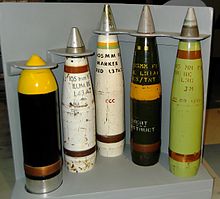FV433 Abbot SPG
| FV433 Abbot SPG | |
|---|---|

FV4 Abbot SPG in the Royal Artillery Museum (around 2006) |
|
| General properties | |
| crew | 4 on board (commander, driver, radio operator, gunner) + 2 loaders in the support vehicle |
| length | 5.84 m |
| width | 2.64 m |
| height | 2.48 m |
| Dimensions | 16.5 tons |
| Armor and armament | |
| Main armament | 105 mm L13A1 cannon |
| Secondary armament | 7.62 mm Fla-MG Bren , six smoke throw cups |
| agility | |
| drive | 6-cylinder diesel engine K60 Mk 4G Rolls-Royce 240 hp (179 kW) at 3750 rpm |
| suspension | Torsion bar |
| Top speed | 47 km / h |
| Power / weight | 14.5 hp / ton |
| Range | 390 km |
The FV433 Abbot SPG (German: Abt ) is a British self-propelled gun . It was introduced to the armed forces in 1965 and its retirement began in the 1980s.
history
After the end of World War II , the British military recognized the possibilities for armored and high-speed self-propelled guns and artillery. Good experiences with the war models Archer and Sexton consequently led to a further development of the armored artillery. The hull of the FV 432 infantry fighting vehicle was used for this . The British used 87.6 mm and 140 mm cannons. With the standardization of the NATO calibers to 105 mm and 155 mm, these experiments became obsolete. The decision was made to use the 105 mm caliber, which was already in use by the British armed forces for the light L5 Pack Howitzer , and a new gun was developed under the name 105 mm L13A1 . The weapon was placed on a FV-432 hull in a large turret that could be swiveled horizontally through 360 °. The gun was expressly designed for direct fire, the weapon could be aimed vertically from −5 ° up to + 70 °. The armor was designed weakly with 6 to 12 mm, a pressure system should protect the crew from warfare agents.
The vehicle was considered robust and reliable.
Abbots remained in the service of the British Army until the 1980s and were gradually replaced by the M109 Paladin . India had upgraded Abbots in service for even longer. These were equipped with improved night vision devices.
Organization and commitment
organization
The British Army also used the Abbot in divisional and corps artillery. In the British Army of the Rhine (BAOR) it replaced the 155 mm M44 self-propelled howitzer from American production from 1966 . It was combined with the larger -caliber M109 and M110 weapon systems. For example, one of the BAOR divisions on German soil during the Cold War in the 1970s had two artillery regiments: one with 24 Abbots and another with twelve M109 and four M110 howitzers.
Use and ammunition
An Abbot self-propelled gun carried 40 105-mm shells, six of which were mostly HESH anti-tank projectiles, which could be used for direct fire in an emergency for self-defense. For a short time, a well-rehearsed team could fire up to 12 grenades per minute. The maximum range, depending on the ammunition used, was up to 15,200 meters with standard Mk1 series bullets and 17,500 meters with improved Mk2 shells. The reason for the different ranges was the propellant charge used : the more modern Mk2 shells could be fired with a stronger propellant charge.
Mk1:
- L42 10.50 kg HESH anti-tank grenade with 2.5 kg RDX filling, 494 m / s muzzle velocity
- L51 15.98 kg smoke grenade with white smoke
Mk2:
- L31 - 16.01 kg high explosive grenade , filled with 2.5 kg RDX (version A1) or TNT (version A2)
- L43 BE (Base Ejection) - 15 kg light grenade with a burn time of around 30 seconds, triggered at a height of 400 meters
- L45 - 15.8 kg smoke grenade with white smoke, hexachloroethane filling
- L36 BE (Base Ejection) - smoke grenade with white smoke
- L37 - target marker grenade with red smoke
- L38 - target marker grenade with orange smoke
Individual evidence
- ^ A b c d Philip Jobson: Royal Artillery Glossary of Terms and Abbreviations: Historical and Modern. History Press, 2008, ISBN 978-0-7509-8007-4 .
- ^ Graham Watson, Richard A. Rinaldi: The British Army in Germany. An Organizational History 1947-2004. Tiger Lily Publications Llc., 2005, ISBN 978-0-9720296-9-8 , p. 75.
- ^ The National Guardsman. National Guard Association of the United States, 1972, 8.
- ^ "High explosive Squash Head - Semi-fixed round" on jcammo.com
- ↑ "Type: High explosive - Semi-fixed round" on jcammo.com
- ↑ "Type: White Smoke - Semi-fixed round" on jcammo.com
literature
- Ian Hogg : 20th Century Artillery. Gondrom Verlag, Bindlach 2001, ISBN 3-8112-1878-6 .
